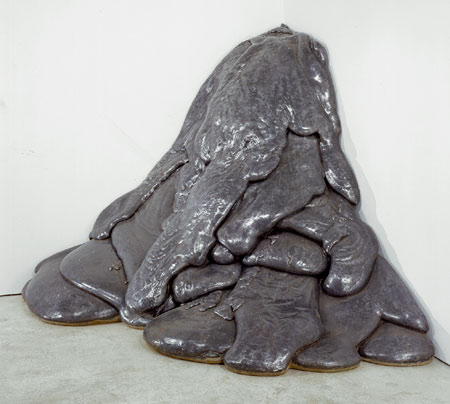
This past weekend I attended the symposium “What’s at Stake? New Topographics: Photography and the Man-Altered Landscape”. The talk included lectures and discussions on LACMA's current show which is a reenactment of the groundbreaking 1975 exhibition
New Topographics.
New Topographics was curated by William Jenkins at the International Museum of Photography at the George Eastman House in Rochester, New York and included the work of Robert Adams, Lewis Baltz, Joe Deal, Frank Gohike, Nicholas Nixon, John Schott, Stephen Shore, Henry Wessel, Jr., and Bernd and Hilla Bechner. The style of the photography is photography seemingly without style—a deadpan look at American (and in the Bechners’ case European) life without nostalgia, devoid of monumentality. The work is reminiscent of Ed Ruscha’s artist books like “34 Parking Lots” and he is cited as an influence by many of the artists involved in the show. Using conceptual art techniques such as seriality and systems, they worked with alleged detachment which gives the pieces in the show a cool appearance. Their subjects are the banalities of everyday life--from industrial office buildings, as in the work of Lewis Baltz, to the grain elevators of Frank Gohlke.


LACMA’s current reenactment of the show runs from October 25-January 3, 2010 and includes more than two-thirds of the photographs by the original participants along with supplementary work related to the show. This includes a few of Ruscha’s artist books along with Robert Smithson’s original article on the Monuments of Passaic and Dan Graham’s “Homes for America”. There is also a first-edition copy of Robert Venturi and Denise Scott-Brown’s
Learning from Las Vegas (which is also available in Oxy’s special collections, as is Ruscha’s
Every Building on the Sunset Strip).

On hand to speak about this important exhibition was an esteemed group of panelists, including Douglas Crimp. Although I was unable to attend the first session in which Crimp, Philipp Kaiser, Britt Salvesen and Richard Meyer were discussing the question of curatorial reenactment, I was able to participate in the second session “Learning from New Topographics.” The speakers were Matthew Coolidge of The Center for Land Use Interpretation (CLUI), professor Norman Klein, and Christopher Hawthorne, architecture critic for the Los Angeles Times. They discussed New Topographics in the context of the 1970s: the energy crisis, political turmoil, war and particularly the context of man’s relationship to the land—issues which were being grappled with in
New Topographics and still resonate today.
Coolidge related Los Angeles’s intimate relationship with oil and shared his research on this history of Los Angles as an oil field. In the re-staging of
New Topographics at LACMA, CLUI added a high-definition video of a flight over the oil pumps at Kern County. The piece resonates with the show because it has the feeling of detached documentation, yet while watching it—seeing miles of oil infrastructure and hearing the sounds of the helicopter mix with the ominous hum of oil pump machinations—one is faced with man’s vast alteration of this desert(ed) landscape.
Christopher Hawthorne looked at the connections between
New Topographics and what was happening in architecture at that time. This is a particularly significant topic because most of the work in
New Topographics features the built environment. Hawthorne explained that the show presented a landscape and building as it is—with banality and detachment. He also looked at the seriality of these works, and the photographic medium juxtaposed with buildings, of which there is generally only one. An audience member asked the fascinating question of Hawthorne: "what about tract homes? Couldn’t they be viewed in terms of seriality?” The tract home does seem to be a huge influence on many of the artists in the show, particularly Lewis Baltz and I find that to be a more interesting connection than Hawthorne’s focus on the monumental building. Hawthorne also brought up how
New Topographics connects to today in that the show looked at how people were taking over the environment and now environmental anxiety (along with economic anxiety) is taking over us. To press this point he presented fascinating pictures from Detroit which showed abandoned houses overrun by nature. These current pictures mirror some of the work in the 1975 show which also shows homes with vastly overgrown yards.
At the end of the talks was a preview screening of James Venturi’s documentary on his architect parents “Learning from Bob and Denise.” In their groundbreaking book of 1972
Learning from Las Vegas, Robert Venturi and Denise Scott-Brown made it okay to look at “ugly and ordinary” buildings as something worthy of study. The documentary preview provided an excellent coda to the discussion of a show which used art techniques of systematizing and seriality to critique the obfuscation of the banalities of modern life.
 More in line with Taylor's description of Davis's work is her "Meat" series. In these works of the past few years Davis sculpts pieces of meat into geometric shapes and places the forms in incongruous spaces. Here are some of the more interesting photos:
More in line with Taylor's description of Davis's work is her "Meat" series. In these works of the past few years Davis sculpts pieces of meat into geometric shapes and places the forms in incongruous spaces. Here are some of the more interesting photos:





















